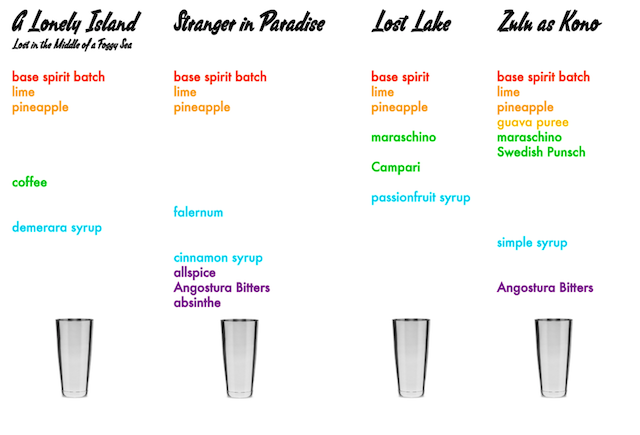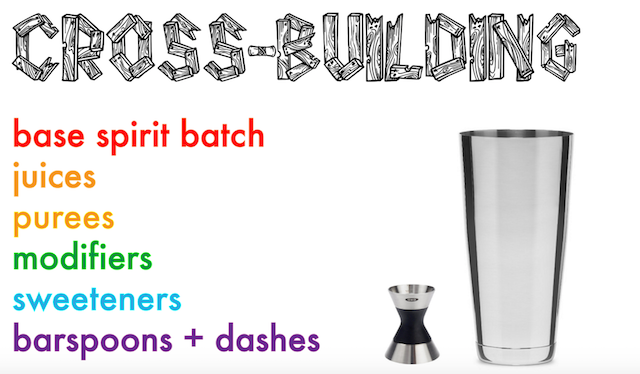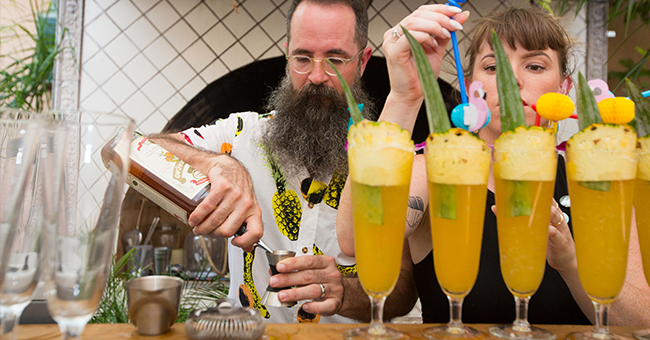In a tiki or high-volume bar where speed and consistency are big factors, cross-building cocktails affords bartenders an efficient method for creating multiple drinks together with varying ingredients without sacrificing quality or their sanity.
Paul McGee, owner of Chicago tiki bar Lost Lake, teaches cross-building to his staff as an efficient and consistent method for expediting the crafting of multi-ingredient cocktails — especially with a menu full of drinks whose list of ingredients can reach as many as ten.
“We picked up the technique during speed rack training and tweaked it to fit our needs at Lost Lake. It teaches bartenders not to waste any movement behind the bar. Cross-building keeps your recipes and ingredient placement categorized both in your head and in the bar’s well,” McGee says.
When building five drinks at once, for instance, McGee begins by pouring the base spirit for each cocktail into their respective tins. He then moves on to juices, purees, modifiers (like falernum or dry curacao), sweeteners and finally bar spoons or dashes before adding the final touch — garnishes.
“The point is, if you have a bottle in your hand, that bottle might also be needed in three of the five drinks you’re building. Instead of dropping it only to pick it back up again, you build each drink based on a categorized system of ingredients.”
Lost Lake’s Cross-Building Method


Systemizing the process of building multiple drinks allows bartenders working in high volume environments to achieve the following behind the bar:
- Efficiency in movements
- Keeping a manageable pace with incoming tickets
- Not becoming overwhelmed
- Consistency in drinks
- Building muscle memory and speed
“Our bartenders are still testing each drink before they are delivered to guests. We’ve rarely had to remake one using this technique. Unless you lose your place, which cross-building aims to avoid, each drink you put out is created consistently,” McGee says.
Lost Lake trains their staff to cross-build no more than six drinks at a time to ensure guests aren’t left waiting for more than a few minutes. By incorporating a system in which to build drinks, McGee says the bartender has only to look at the bottle in their hand to remember where they are in the process.
Jeff “Beachbum” Berry’s tiki lounge Latitude 29 in New Orleans employs cross-building behind its bar in order to meet guests expectations of both speedy service and a damn good drink.
Brad Smith, Latitude’s beverage manager and 23-year bartending veteran, developed his cross-building methodology while working at new wave tiki joint Psycho Suzi’s Motor Lounge in Minneapolis, later refining it at a high-volume craft cocktail bar where he was not only charged with producing beautifully concocted drinks, but getting them into the hands of eager guests quickly.
“At Latitude there is an equal expectation of drink expediency and quality. Tiki bartending at this level is difficult. You really have to be at the top of your game. Working the service well is like playing chess, you’re always thinking eight steps ahead. It’s strategic and methodical without appearing so,” Smith says.
Latitude has their well divided into zones: juices in the first area, syrups in the second, modifiers in the third and so on, with the last zone designated for the base spirits. Smith prefers his bartenders to build drinks starting with the juices and syrups first — adding the base spirit as the last ingredient in order to avoid throwing a drink away with the most expensive ingredient already poured if you lose your place.
“When you have five tins in front of you and two blenders cups, start with the first zone which for Latitude is juices. Pick up the first juice and pour it into each tin or cup requiring it, then move down the line to the next juice. When you’re finished with your juices, move on to the next zone — for us that’s syrups, and repeat the process in that zone. After you’ve run through each of your zones and gotten through all of the ingredients needed for each drink you’re building, you will have only touched a bottle once for each particular setup of drinks,” Smith says.
By dividing your well into zones and placing ingredients in the same area day-after-day, you develop muscle memory and will no longer need to refer to labels when mixing drinks. You’ll always know the first row, third bottle down is <insert ingredient here>.
However, Smith cautions cross-building isn’t a technique you master overnight. You aren’t going to start knocking out six shaken cocktails and two blender drinks right off.
“It takes about six months or Tales of the Cocktail (whichever comes first) to master. If you go through Tales first, you’ll definitely have cross-building down by the end of the week. You’ll have no choice! Tales makes you a speedy bartender,” Smith jokes.
“Start small and slow. Know your products and your recipes well before incorporating cross-building behind the bar. It takes time and a lot of practice to train your brain. Best advice I can give is to remain calm and enjoy the process of learning. One day it will all just click.”





